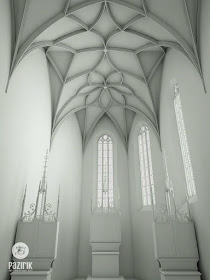 |
| Virtual reconstruction of Bonyhád church |
I wanted to give an update about the situation with the excavation of the medieval church of Bonyhád. Unfortunately, the excavations could not be completed fully. Once the very short-term permit ran out, work on the excavations had to stop on October 7th. More than a month passed until the possibility of continuation was debated - a precious month with good weather, during which a lot of progress could have been made. Starting from mid-November, 2015, the excavated ruins of the medieval church were covered up and filled with concrete, so the new road could be built over them. As a results of this, unfortunately a lot of the questions surrounding the church could not be answered. I talked to the chief archaeologist, Géza Szabó, and he provided some information about the church. He explained to me that it is plain to see - even without a full excavation going down to sufficient depth, that the church had at least two phases of construction. The earlier phase can be dated to the period of King Sigismund, and is probably connected to the men found buried in front of the main altar. He was a strong, well-to-do man. Although no tombstone was found, a coin from the rule of Wladislas I. dates the burial to this period (1440-1444), and places the construction of the church to the Sigismund period. The church was later rebuilt, most likely in the early 16th century - this is the date of the late gothic net vault, the fragments of which were found during the excavations. Unfortunately, earlier phases of construction could not be adequately explored, and the area of the church also could not be excavated.

The excavation site during my visit in late October
Because of the very short period available for archaeological excavation, and the impossibility of examining the site in the future, documentation was of paramount importance. In the following, I would like to illustrate some of the techniques used during the work carried out. The site itself was documented in a 3D photogrammetric survey, recording all details by Interspect Research Group. 3D modelling company Pazirik also scanned the site, and carried out 3D scanning of the architectural fragments, which then served as the basis of a theoretical 3D reconstruction of the early 16th century phase of the building.
 |
| Virtual reconstruction of the church at Bonyhád |
Based on a keystone and several vault fragments, the intricate late Gothic net vault of the church was also reconstructed. These reconstructions, and initial results of research were published by Archeologia.hu. The articles published in this collection not only make preliminary results and wonderful illustrations available, but also reveal that there are still several questions surrounding the remains - questions, which largely could have been answered via a thorough and complete archaeological excavation. Current legislation in Hungary unfortunately makes it possible that the construction of a road could proceed, without the completion of this archaeological survey.
 |
| The site being covered over (mid-Novermber, 2015) |
Sources:
A középkori templom feltárása Bonyhádon - article (pdf, in Hungarian), Archeologia - Altum Castrum Online Magazin.
I am happy to find your distinguished way of writing the post. Now you make it easy for me to understand and implement the concept. Thank you for the post. Pikdo is an Instagram Online Viewer that you can easily browse users, location, followers, hashtags, popular contents, statistics and much more.
ReplyDelete